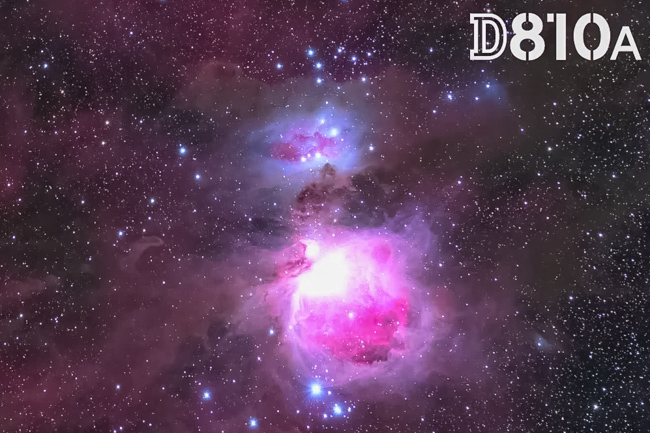

Astrophotography has seen a significant spike in the past few years, with the advent of digital SLR cameras and significant leaps being made in the field of high-ISO image quality.
And rightly so – imagine being able to immediately see images you capture of the deepest, farthest reaches of space! To me, as a casual fan of astronomy and a more serious addict of night-landscapes in general, it is actually surprising that more of these types of cameras haven’t surfaced yet.

Then again, I have to warn you right off the bat – this camera is not recommended for use in normal photography, and its price is a not-so-paltry $3796. This is for serious astrophotographers only!
Pre-Order the Nikon D810A here on B&H for $3796.95 (Expected delivery May 28th)
 The Rosette Nebula – Nikon D810A (mounted on a tracking telescope)
The Rosette Nebula – Nikon D810A (mounted on a tracking telescope)
8 images, 300 sec. each @ ISO 800
Nikon D810A Press Release
MELVILLE, NY – Today, Nikon Inc. announced the new D810A, a DSLR optimized for astrophotography and other scientific applications. By modifying the infrared cut filter for the hydrogen alpha wavelength, Nikon has created a camera that gives photographers the ability to capture the diffuse nebulae in the night sky and to create colorful, breathtaking celestial images. The D810A shares its architecture with the powerful and professional high-resolution Nikon D810 DSLR and includes other new features designed uniquely to help capture the cosmos, letting users achieve sharp and vibrant images of the universe.
“The Nikon D810A is engineered exclusively to meet the unique demands of professional and hobbyist astrophotographers,” said Masahiro Horie, Director of Marketing and Planning, Nikon Inc. “The camera’s distinctive feature set and powerful imaging capabilities make it an appealing option for those who are ready to discover the fantastic cosmic features that are hidden among the stars.”
I AM Star Struck: DSLR Optimized for Astrophotography
The Nikon D810A provides hobbyists as well as professional stargazers with a powerful combination of impressive resolution and features specifically created for astrophotography and scientific applications. The infrared (IR) cut filter has been optimized to allow transmission of the hydrogen alpha spectral line, resulting in four times greater sensitivity of the 656nm wavelength. The resulting images capture the brilliant red hues of diffuse nebulae and constellations in striking detail and fidelity. While not recommended for general photography, the D810A is an excellent option for photographing the universe with either NIKKOR lenses or third-party adaptors for telescopes.

In addition to the optimized IR cut filter, the D810A adds other features that are useful for astrophotography applications. A new Long Exposure Manual Mode is implemented, giving users the ability to set shutter speeds from 4, 5, 8, 10, 15, 20, 30, 60, 120, 180, 240, 300, 600 or 900 seconds (15 minutes), as well as Bulb and Time settings. Building upon the D810’s excellent low-light capabilities, the ISO range has been optimized from 200 to 12,800 (Hi-2 51,200), for maximum sensitivity with the optimal signal to noise ratio.
The D810A also adds a new Virtual Exposure Preview Mode, which displays an estimated preview image and is available when shooting at shutter speeds longer than 30 seconds when in Live View. The brightened preview image represents a 30 second exposure, simplifying focusing and composition.
Additional Images & Press

Nikon D810 Initial Thoughts & Opinion


Right off the bat, my first thought is that I really wish Nikon would offer that new extended shutter speed option for ALL its DSLRs! I know that the D810A is optimized for astrophotography, but that doesn’t mean that all of the existing DSLRs are capable of creating good quality images at extended shutter speeds. Using the tried-and-true options for in-camera long exposure noise reduction, I can already create ~30 minute exposures with my D750, D800e, D810, and even my D5300, if the ambient temperatures are cold enough to stave off thermal noise. In short, I wish Nikon’s new high-powered firmware program would bring this feature to other cameras, but I suspect that would be wishful thinking.
So, while this new camera is an incredible toy that I’d love to own, I’m not (currently) a professional astrophotographer so I won’t be purchasing this camera for personal use any time soon.
What are your thoughts? Do you have this kind of cash to spend on a hobby? Or are there any folks reading this who are going to put such a camera as this to professional, lucrative use? I’d love to hear your thoughts in the comment section below!
Pre-Order the Nikon D810A here on B&H for $3796.95
Happy clicking,
=Matt=
Matthew Saville
Follow his wilderness nightscape adventures on Instagram: instagram.com/astrolandscapes




Get Connected!